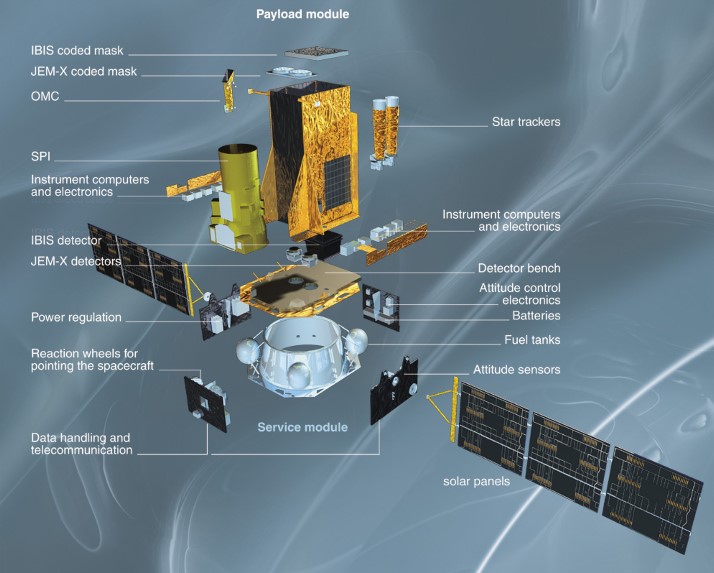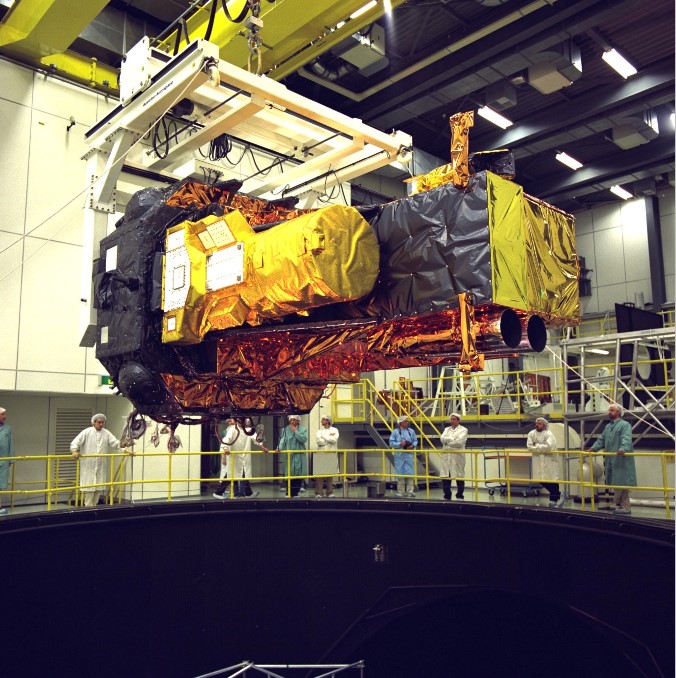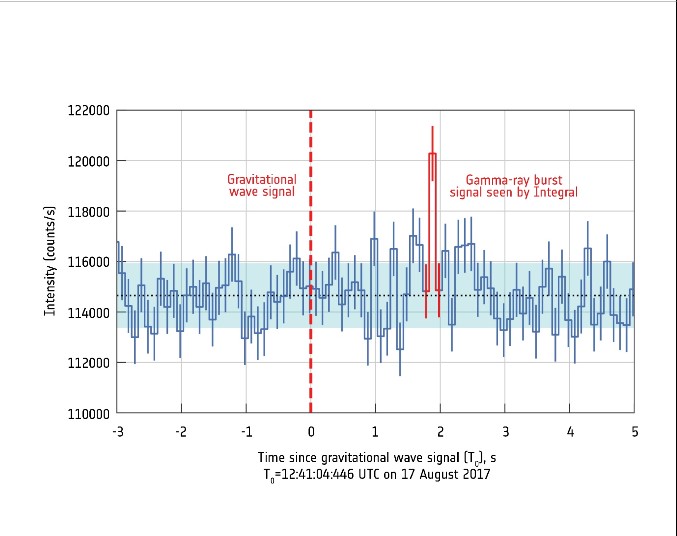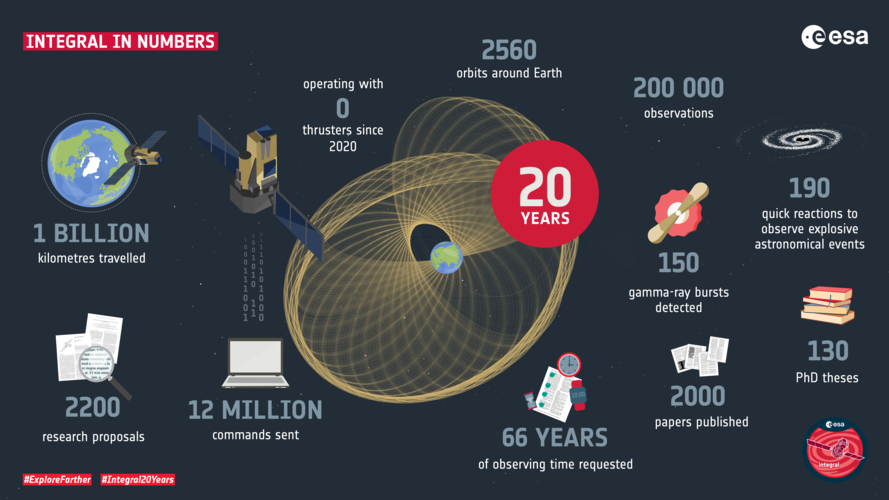Integral, ESA’s International Gamma-Ray Astrophysics Laboratory, was launched on 17th October 2022 from the Baikonur Cosmodrome in Kazakhstan on board a Proton rocket. It was placed in a highly elliptical inclined Molniya orbit which circles Earth once every three days. Such orbit reaches an altitude of 150000 km at perigee (almost halfway between Earth and Moon) allowing the spacecraft a long time of undisturbed observations outside the Earth’s energetic radiation belts which would interfere with the measurement of gamma rays.
Integral Mission Objective
The objective of the mission was to explore the most energetic phenomena that occur in nature and address some of the most fundamental problems in physics and astrophysics.

By observing gamma and X-ray, which are the fingerprints of the nuclear activities inside stars, we can better understand the formation and evolution of the stars, novae and supernovae, neutron stars and black holes. Earth’s atmosphere acts as a shield to protect us from this dangerous cosmic radiation, therefore gamma rays from space can only be detected by satellites.
Most Sensitive Space Gamma-Ray Observatory Ever
Built by an industrial consortium lead by Alenia Spazio (now Thales Alenia Space), the spacecraft hosts two gamma ray, one X-ray and one optical telescope. All four instruments are co-aligned therefore observing the same region of the sky. This allowed scientists to obtain, simultaneously, detailed images and spectra of a high energy source and precisely pinpoint its position in the sky.

At time of launch, Integral was the most sensitive gamma-ray observatory ever put into space. Integral is a very long-lived spacecraft with 22 years of uninterrupted observation. It can still work well, but its retirement time has arrived and, while writing this article, it has ended its scientific duties.
Galactic Bulge: A Dynamic High-Energy Light Show
The central region of our Milky Way, the Galactic Bulge, is a rich host of variable high-energy X-ray and gamma-ray sources which include X-ray binary systems with either a black hole or a neutron star, pulsars and remnants of supernova explosions. A number of these sources only shine brightly for a limited period. The effect of this constantly changing environment gives the Galactic Bulge the appearance of a dramatic cosmic light shows when seen through high-energy glasses. In some cases, these lights appear as a sudden bright flash and disappear shortly afterwards. They are called gamma-ray bursts (GBRs), flashes of energetic light that flare up somewhere in the sky about once per day.
Unraveling The Mystery Of Gamma-Ray Bursts
For long time the origin of such flashes was a mystery. Integral’s observations have been key to solving the mystery: these flashes originate from the collapse of massive stars that go supernova or are due to black holes and neutron starts smashing into each other. An artist’s impression of two neutron stars spiraling towards each other and eventually merging in a huge explosion of energy can be seen in the video below.
The Thrill Of Serendipitous Discoveries
When one uses a telescope to explore the sky there is always a scientific objective and an associated plan of observations. However, what scientists always hope for is a serendipitous discovery, something which was neither planned nor expected. It turned out that Integral was able to track down a source in the sky that generated a gravitational wave.
The First Detection Of Gravitational Waves
Gravitational waves are transient in a gravitational field generated by cataclysmic events involving large masses, like stars. At the time of Integral’s launch, scientists were not sure that gravitational waves could ever be detected. The first direct observation of gravitational waves was made in September 2015, when a signal generated by the merger of two black holes was received by the LIGO gravitational wave detectors in the US. This later gave grounds for the Nobel Prize in Physics to be awarded to the key scientists involved in the discovery.
A Groundbreaking Discovery: Light And Gravitational Waves From The Same Event
On 17th August 2017, a burst of gamma rays was recorded by Integral and NASA’s Fermi satellite. Just seconds before the two satellites saw the gamma rays the LIGO detector was triggered by the passage of gravitational waves. The observations indicated that the gravitational waves and the gamma-ray burst originated from the same cosmic event: the collision of two neutron stars. About half a day after the detections, scientists at various optical observatories, including the European Southern Observatory’s telescopes in Chile, spotted something new near the core of galaxy NGC 4993. It was the aftermath of a neutron star collision. This was the first discovery of gravitational waves and light coming from the same source.

The Final Chapter Of The Integral Mission
The last full science operational orbit of Integral was number 2864. After more than 22 years looking into the depths of our universe, today Integral’s sensitive instruments have stopped collecting scientific data. The switch off was the beginning of March 2025 even though a small radiation monitor will continue collecting data during the pass of the spacecraft through the Earth’s radiation belt. From April onward the ground station coverage will be reduced to a minimum only to monitor the safety of the spacecraft which will continue to orbit Earth for four more years. ESA engineers will monitor the satellite until it will re-enter Earth’s atmosphere in February/March 2029. The remains of the spacecraft which will not burn crossing the Earth’s atmosphere will splash in the Indian Ocean.
Lasting Legacy Of Integral

Integral, which was initially planned for a scientific mission lasting no more than five years, has by far exceeded the required lifetime. The data sets released so far have been heavily used by astronomers and astrophysicists across the world but its legacy will serve scientists for many more years to come. The data collected will be essential for future research and they will keep astronomers and astrophysicists of the world busy in the next future.